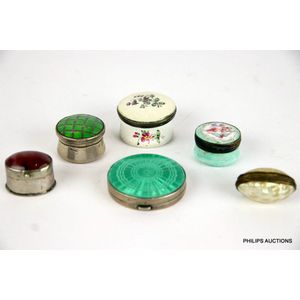Antique and Vintage Pill Boxes and Compact Collection
You must be a subscriber, and be logged in to view price and dealer details.
Subscribe Now to view actual auction price for this item
When you subscribe, you have the option of setting the currency in which to display prices to $Au, $US, $NZ or Stg.
- Mother-Of-Pearl - Mother-of-pearl, technical name "nacre", is the inner layer of a sea shell. The iridescent colours and strength of this material were widely used in the nineteenth century as an inlay in jewellery, furniture, (especially papier mache furniture) and musical instruments.
In the early 1900s it was used to make pearl buttons. Mother-of-pearl is a soft material that is easily cut or engraved.
Nowadays it is a by-product of the oyster, freshwater pearl mussel and abalone industries. - Agate - Agate is a type of semi-precious gemstone that is made up of silica dioxide, a mineral that is also found in quartz. It is known for its distinctive banded patterns, which are created as layers of silica are deposited in different colours including red, orange, yellow, green, blue, and purple. It is often used in jewellery, decorative objects, and other decorative items, and it is prized for its beauty and durability. Agate is found in many parts of the world, including Brazil, India, and the United States.
- Guilloche - A form of classical decoration consisting of a repeating ornament of interlacing curved bands, sometimes forming circles, and further decorated with rosettes or other flower forms.
The name is derived from the inventor, French engineer Guillot, who invented a mechanical method of inscribing fine repeating patterns on to metallic surfaces.
On enamelled items with guilloche decoration, the surface is firstly engraved with the repeating pattern, and then covered with several layers of enamel, each of which is fired.
Where the item has not been enamelled the form of decoration is usually called "engine turned".
This item has been included into following indexes:
-
boxes, material or decoration
- enamelled boxes 181
- ormolu and gilt boxes 224
Visually similar items

Selection of Chinese pottery from the Tek Sing shipwreck, including four small blue and white bowls, four spoons, two blue and white dishes and six olive-brown glazed saucers. Diameter 18.5 cm max

Ming period stoneware oil lamp, tin slip glaze, circa 1400. Together with under glaze blue tea bowls and vases.

Poole pottery dinner service, feather drift pattern designed by Alfred Read comprising two ashes, lidded tureen, 6 dinner plates, 6 luncheon plates, 6 side plates, 6 cups and saucers, 6 side plates and 6 coupes

Set of four dark purple Ruskin buttons
